Subscribe now to get notified about IU Jharkhand journal updates!
Management of ground nut cultivation: enhancing productivity and promoting seed storage Divya Chirayath, Policy analyst, CGBA, Delhi
Abstract :
Jaleswar Block, on the Odisha –West Bengal border in the eastern state of Odisha, India, is one of the four Notified Area Committees (NAC’s) in Balasore district. River Subarnarekha passes through this block making the soil in the villages on the riverside extremely fertile and conducive for agriculture. The area comprises of mostly marginal farmers and agriculture is the main source of income. Despite the high productivity of the area, the farmers remain underserved across many stages of the agriculture value chain, especially input supply and information services.
This project is a small attempt to address some of these issues through community participation to help farmers improve their yields. The project mainly involves the introduction of a new variety of groundnut with the purpose of increasing yield, promoting proper spacing while sowing and promoting the ecologically sustainable idea of conserving seeds.
Keywords :
Agricultural value chain, Notified Area Committees, Agrarian woes, Food security, Landholding, Intervention, Marginal farmers, Green revolution,Introduction
The agriculture sector employs more than half of the Indian population. This figure alone makes it incredibly important to look at the agrarian woes through the lives of farmers and just from the point of view of food security alone. More than 80% farmers in India are marginal farmers with landholdings less than two hectares. Therefore any intervention in agriculture should be centered on these marginal farmers who form the bulk of the farming community.
When this project took off in September, paddy was being harvested and the next crop to be sown was groundnut. The authors decided to study the practices in groundnut cultivation. Through their stay in the village, they were able to observe that acquiring seeds was a tedious task. It was quite surprising to note that seeds- the basic input in farming, had to be bought each season. It was found out that, not only were seeds difficult to procure, most farmers were unsatisfied with the quality of seeds. Groundnut is essentially a cash crop here, hence marketing of the crop is more convenient than availing seeds. The heavy dependence of farmers on external inputs is one of the manifestations of ‘Green revolution’. In the name of technology, farmers have been made dependent even for seeds- the very nature of which is to be conserved. Therefore, it was decided that the intervention should aim at making farmers self-sufficient in seeds.
Groundnut cultivation in the village ‘Bago’ is done in the Rabi season- November- May on residual soil moisture, one-two months after the harvest of the Khariff paddy. All the 50 households in this village cultivate groundnut during the Rabi season, essentially because it requires no water (entirely rain- fed), requires lesser field preparation than paddy and fetches good prices.
Once the crop was fixed, it was decided to observe the practices in groundnut cultivation as the sowing season was about to begin. Through Focused Group Discussions (FGDs), personal interactions with farmers, government officials and a few scientists from OUAT (Odisha University of Agriculture and Technology), it was found out that the two major issues the farmers faced were: (1) unavailability of good seeds
; and (2) seed rate followed is much higher than recommended.
(1)Unavailability of good seeds
Like most regions where commercial farming is practiced, there are two sources of seeds available to farmers: seeds from private traders at market prices or seeds from the state seed corporation at subsidized rates (direct benefit transfer).
Both sources provide seeds without certification and labels and are not very different in quality. Table 1 shows sources of groundnuts seeds.

(2) Seed rate much higher than recommended
Seed rate is the amount of seeds used per unit area. The farmers in the project location use much more seeds than is recommended for groundnuts. The recommended seed rate for groundnuts is 40-45kgs/acre, while the farmers here use 60-80kgs/acre. The reasons for this include the fear of low germination, not following a fixed spacing while sowing, no proper technology like SRI (System of Rice Intensification) for groundnuts and the general notion that more seeds sown will inevitably result in higher yield.
The farmers used almost double the amount of seeds that was recommended for the crop, mainly because the germination percentage of the seeds is not guaranteed. The farmers buy seeds each season from private traders or from the government dealer of seeds which they get at a subsidy of 25%, as opposed to the ecologically and economically sustainable option of conserving seeds. The farmers do not know the source, variety, quality and other characteristics of the seeds and are bound to use the seeds because of the lack of choice. Because the famers use much more seeds than recommended, the space between seeds is much lesser than recommended, eventually leading to lesser number of pods/plant than the national average. The village selected for the intervention had about 50 households. Table 2 shows landholdings of the farmers in the study area and Figure 1 shows the cost of groundnut cultivation.
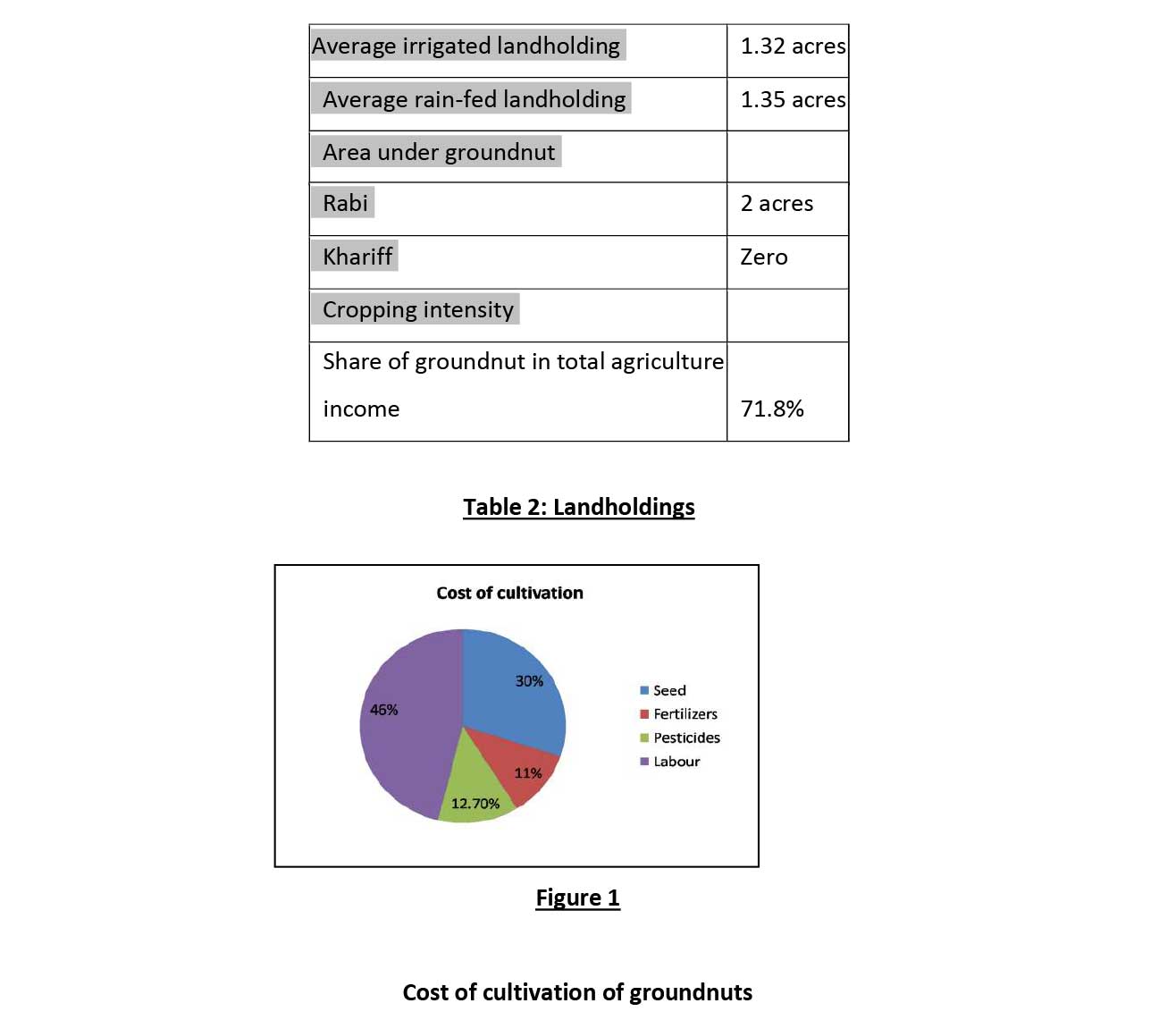
Block Profile
Jaleswar is a small town in Balasore district of the state ‘Odisha’ and is adjacent to border of West Bengal. Jaleswar block consists of 144 villages and Jaleswar town forms a state constituency along with Baliapal Block. Jaleswar block has a population of 204090.Males constitute 51% of the population and females 49%. Jaleswar has an average literacy rate of 65%, higher than the national average of 59.5%: male literacy is 73%, and female literacy is 57%. In Jaleswar, 14% of the population is under 6 years of age. Figure 2 shows the maps of Balasore district and Jalaswar block.
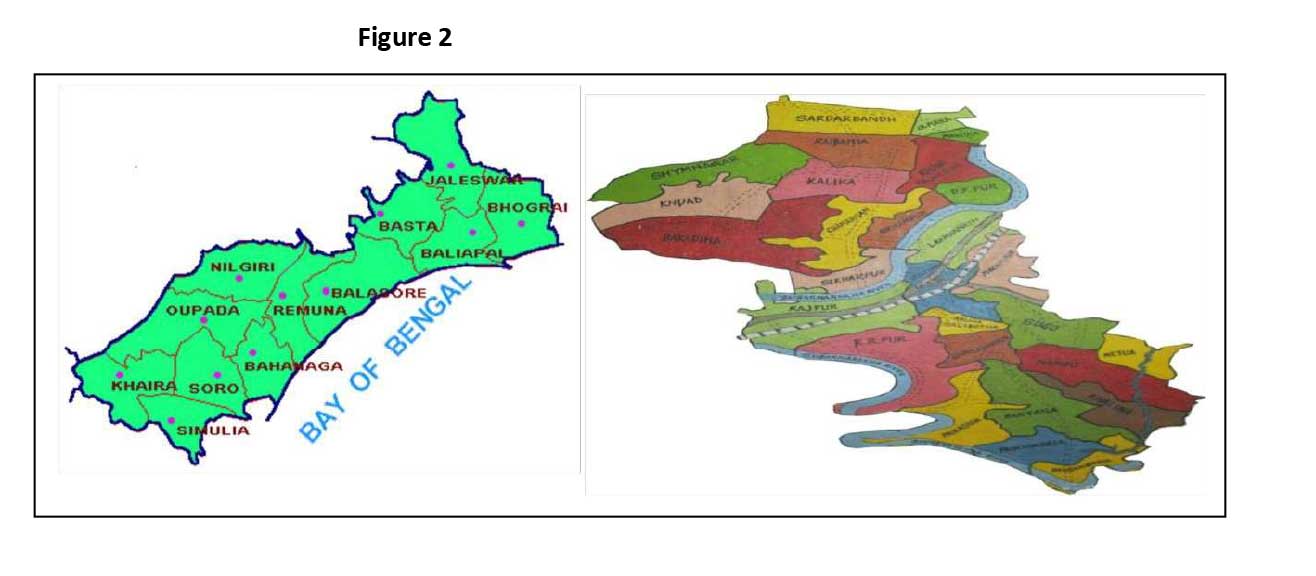
Maps of Balasore district and Jaleswar block
Jaleswar lies on the Northern most corner of Odisha on the Odisha-West Bengal border, with the nearest city being Balasore (54.1 km) and Kharagpur (91.4km).
Distribution of agricultural land
Table 3 and Figure 3 show the distribution of agricultural land and season wise distribution of agricultural land.
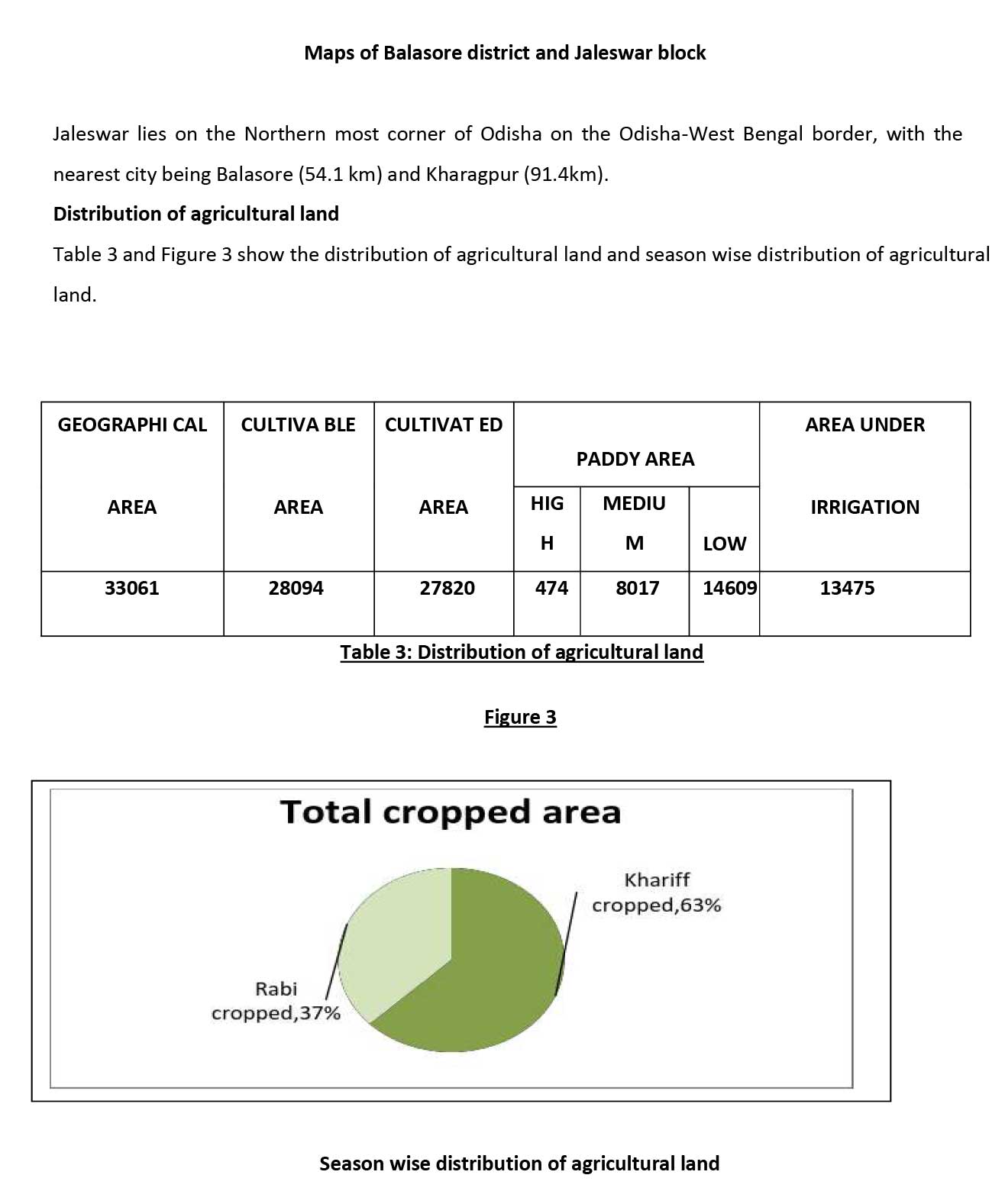
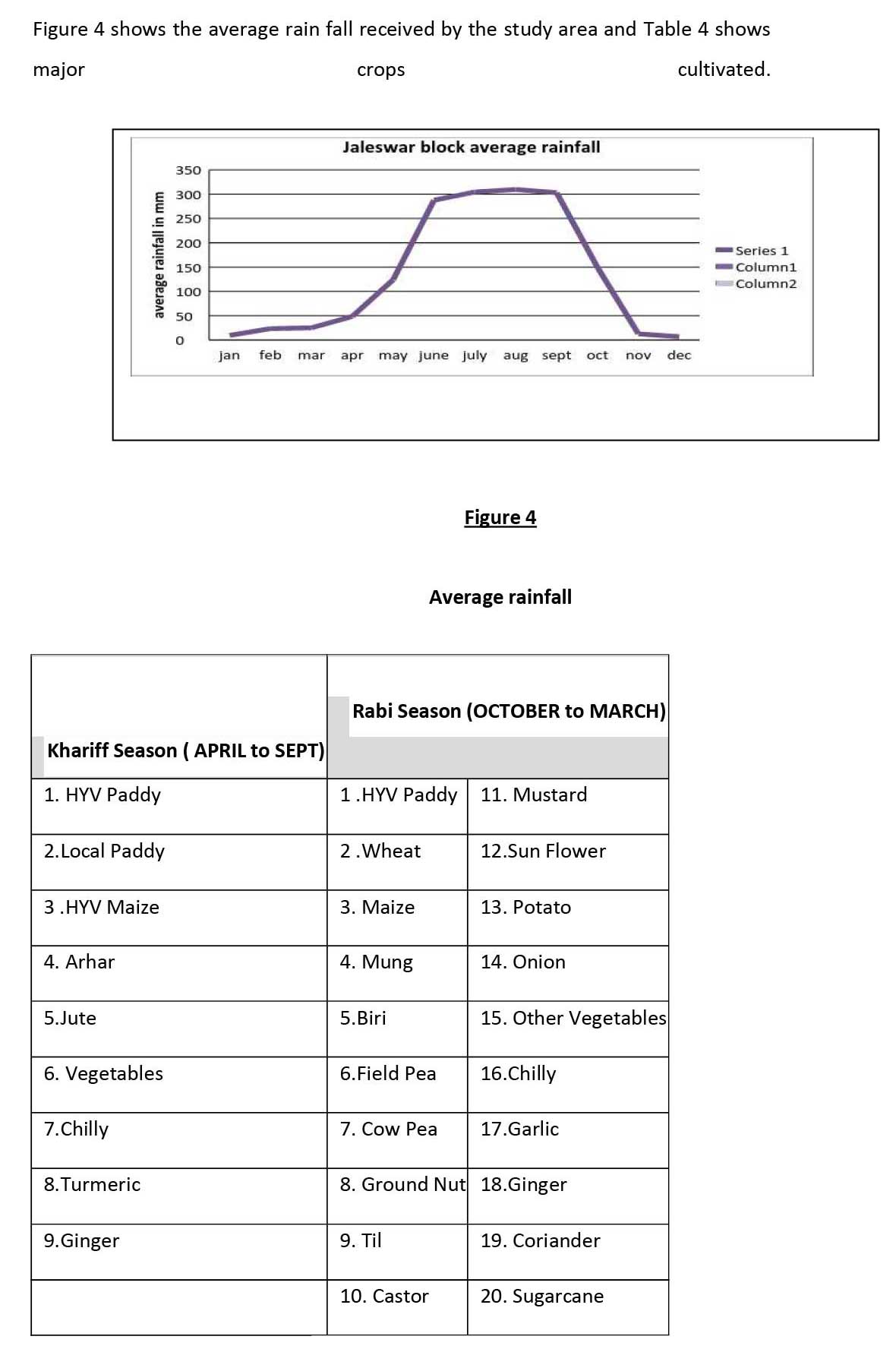
Needs assessment and main objective of the study
Groundnut cultivation in the village Bago is done in the Rabi season- November- May on residual soil moisture, one-two months after the harvest of the Khariff paddy. All the 50 households in this village cultivate groundnut during the Rabi season, essentially because it requires no water (entirely rain- fed), requires lesser field preparation than paddy, and fetches good prices.
The main objective of this project was to design an intervention through which farmers can get access to a good variety of groundnut, multiply it and learn to conserve seeds so that they do not have to depend on external sources every season. The project also aims at reducing seed rate by promoting proper spacing while sowing, which not only reduces seed rate but also enhances productivity.
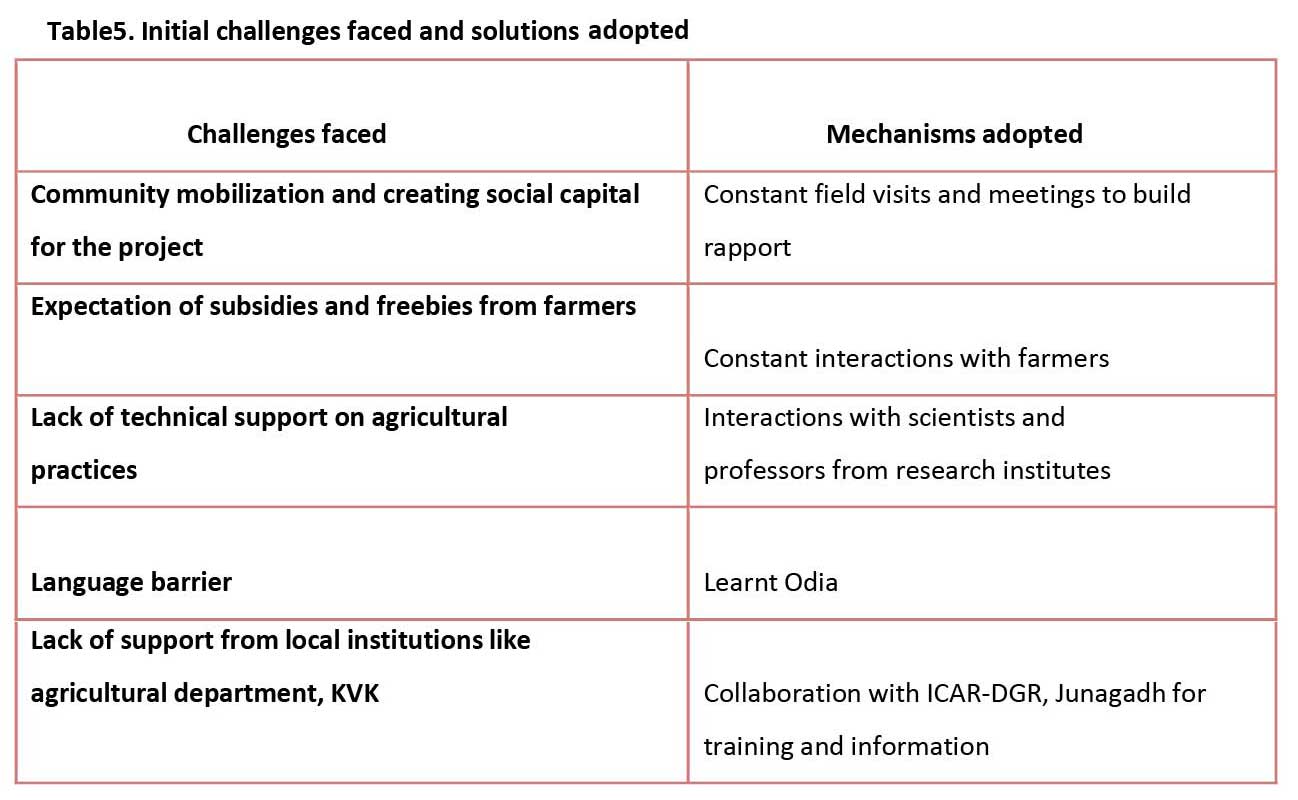

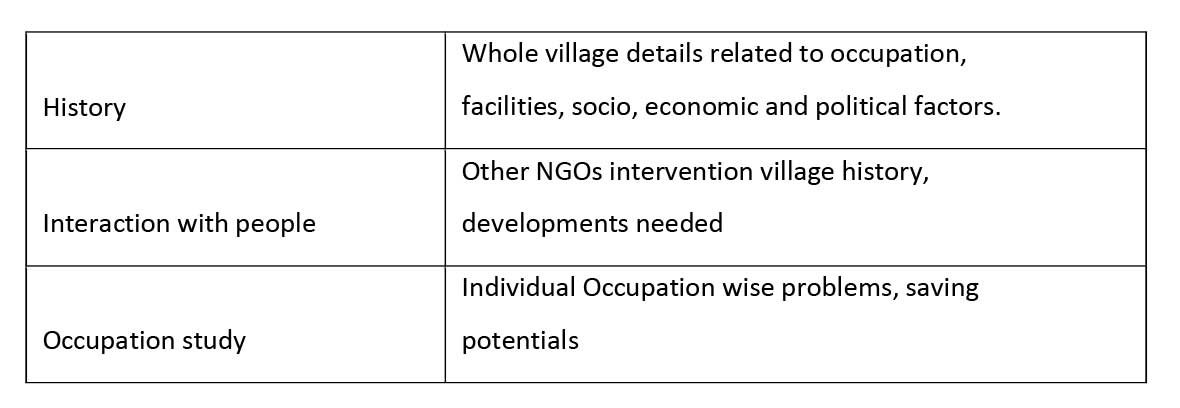
Table 9: Secondary Data Sources
Project Design
The project was designed keeping in mind the timeline of the Rabi and Khariff season. The following steps were taken to execute the implementation of the project.
Formation of social capital for the intervention
The initial challenge was to mobilize farmers through Focused Group Discussions (FGD’s), interactions and personal interviews. It was decided to form a Resilient Microfinance Group (RMG) for farmers. An RMG is similar to an SHG, performs the same functions of thrift and credit, with the exception that the members of this group should mandatorily be farmers.
A group of 15 male members was formed and president, secretary and treasurer were elected from within the group. The group functions like an SHG, saving Rs.100 per member each month. The idea behind forming such a group was to formally mobilize farmers for the project and facilitate more interventions through the group. The average age of the group members is 43. The average landholding is 2 acres. Monthly meetings were conducted and the issues were discussed.
Institutional training on groundnut cultivation
After the formation of the group, five farmers were taken to ICAR- Directorate of Groundnut research, Junagadh for a three-days training program on better cultivation practices in groundnut. The training covered the best practices in each step from sowing till harvest. The main take-aways from the training were:
- Using the chemical ‘tubeconazole’ as seed treatment instead of theregularly used ‘gamaxine’, ‘babestein’ etc.
- Following recommended seed rate: 40-45 kg/acre, much lesser than the prevalent seed rate: 80-100 kg / acre.
- Following recommended spacing: 30cm between rows and 6cm between plants.
- Using better varieties of seeds that especially developed for this region: like Girnar-3 and Girnar-2 varieties developed for the Eastern states of Odisha, Jharkhand and West Bengal in ICAR-DGR.
- Scientific seed storage practices using desiccants like Calcium chloride, Silica gel, Zeolite beads etc.
The authors took the groundnuts grown by the farmers in the previous season for examination by scientists at DGR. The sample contained a mixture of two-three varieties and traces of Afla-toxin contamination.
After discussions with the Chief plant breeder, Dr. Narendra Kumar, we bought breeder seeds of a variety called Girnar-3, especially developed for the Eastern states of India in 2011 in ICAR-DGR, Junagadh. We bought 8 kg of Girnar-3 at the rate of Rs135/kg. One kg of Girnar-2, another variety developed for the Western part of the country was also bought by us. These seeds were then distributed among a few farmers for trial.
Trials among farmers
The information we received during the training was disseminated to other farmers through a group meeting after the returning to the project location. The meeting was attended by many farmers from the RMG and outside the
RMG. The farmers who attended the training acted as TOTs and passed on the information to other farmers through the meeting and personal interactions.
The line sowing recommended spacing was followed by quite a few farmers only. The existing practice in sowing was broadcasting with the help of animals. The seed rate reduced considerably, with the yield increasing marginally. The farmers followed a spacing of 30 cm between rows and 6 cm between plants. The data for a few farmers who used local cultivars has been documented:
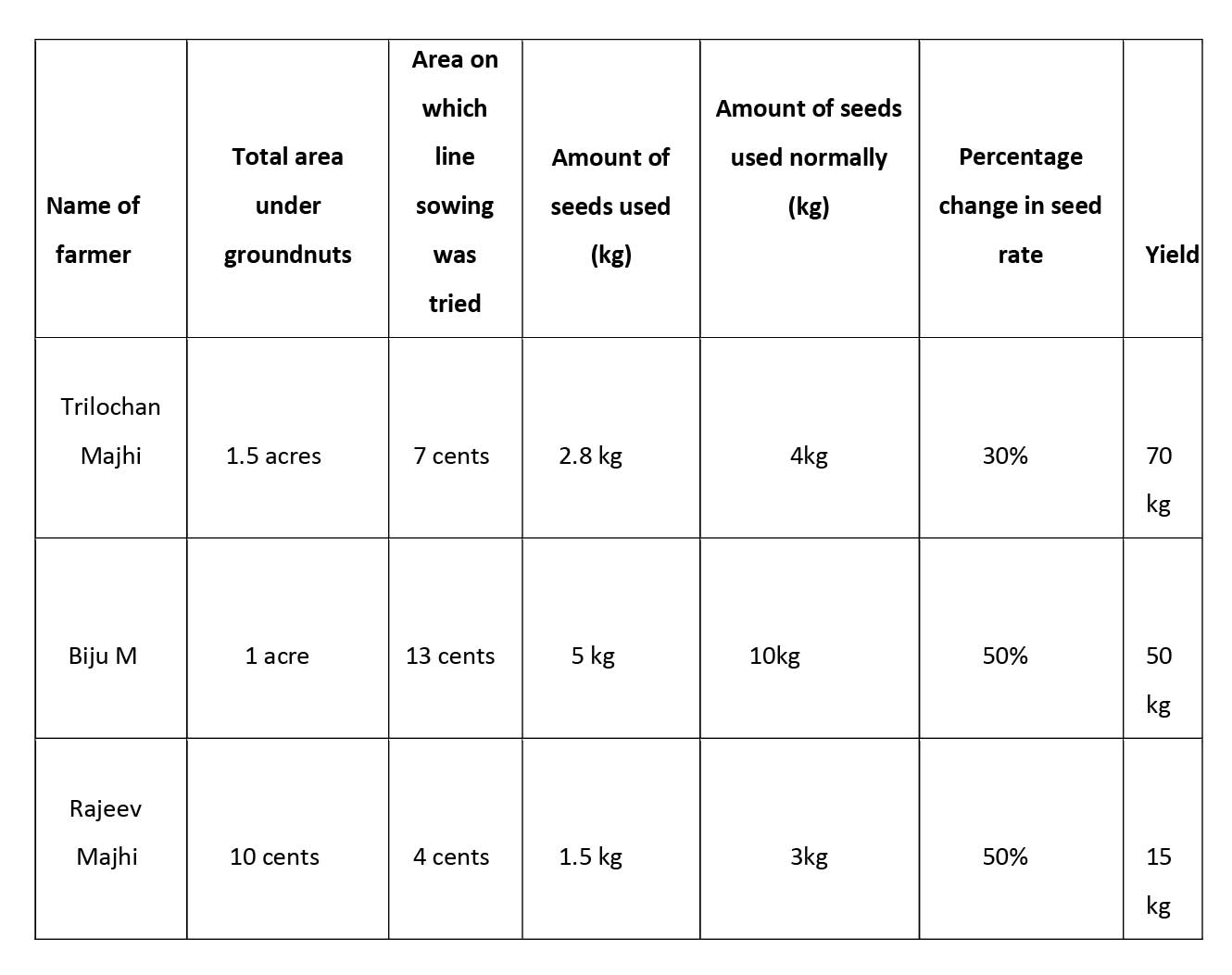 Table 6: Sowing local cultivars following recommended spacing
Table 6: Sowing local cultivars following recommended spacing
Other than decreased seed rate, other benefits of sowing in straight lines are ease in weed removal and watering. The number of pods per plant also increased from 10-12 to 25-30.
Yield from local cultivar- sown with spacing
The 8 kg of breeder seeds we bought were distributed among four farmers. The farmers who volunteered to try out the new variety were given the seeds. The initial germination of the seeds was not satisfactory, mainly because the seeds were sown much later than the local cultivars and the temperature was quite
low (about 13 degrees, compared to 25 degrees required for best germination).
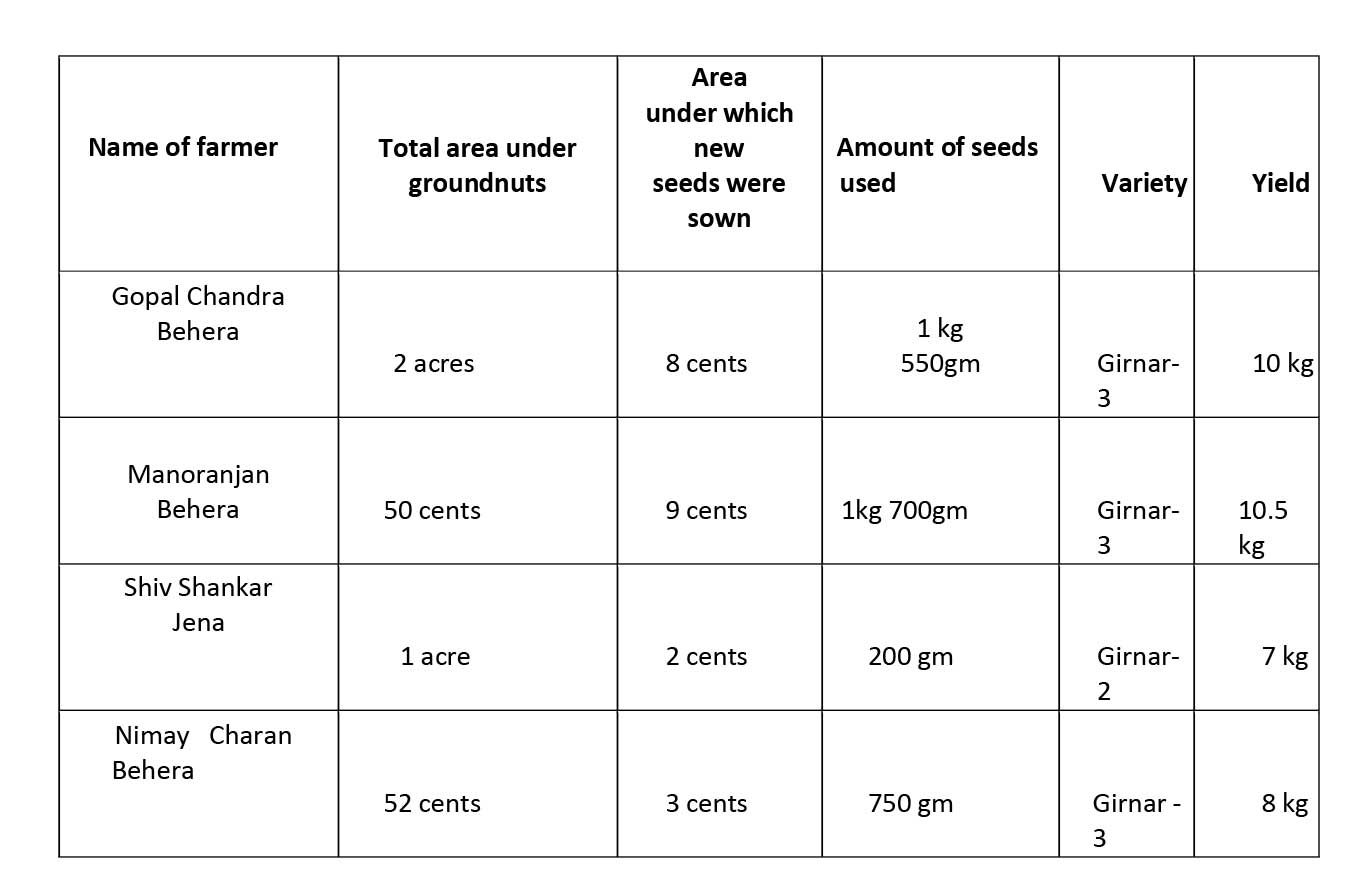 Table 7: Sowing seeds of new varieties
Table 7: Sowing seeds of new varieties
The new varieties outperformed the local cultivars in the following parameters:
Shelling percentage: Groundnuts of this variety have a higher shelling percentage of 65-70% as compared to 60-65% in the local cultivars.
Pods/plant: The average number of pods/plant in this variety is 40, whereas the average number of pods/plant in the local cultivars is 15.
However, the new varieties require water during sowing and pegging stages, to produce best output. Since groundnut in this region is entirely rain-fed, this can be a disincentive in adopting these varieties.
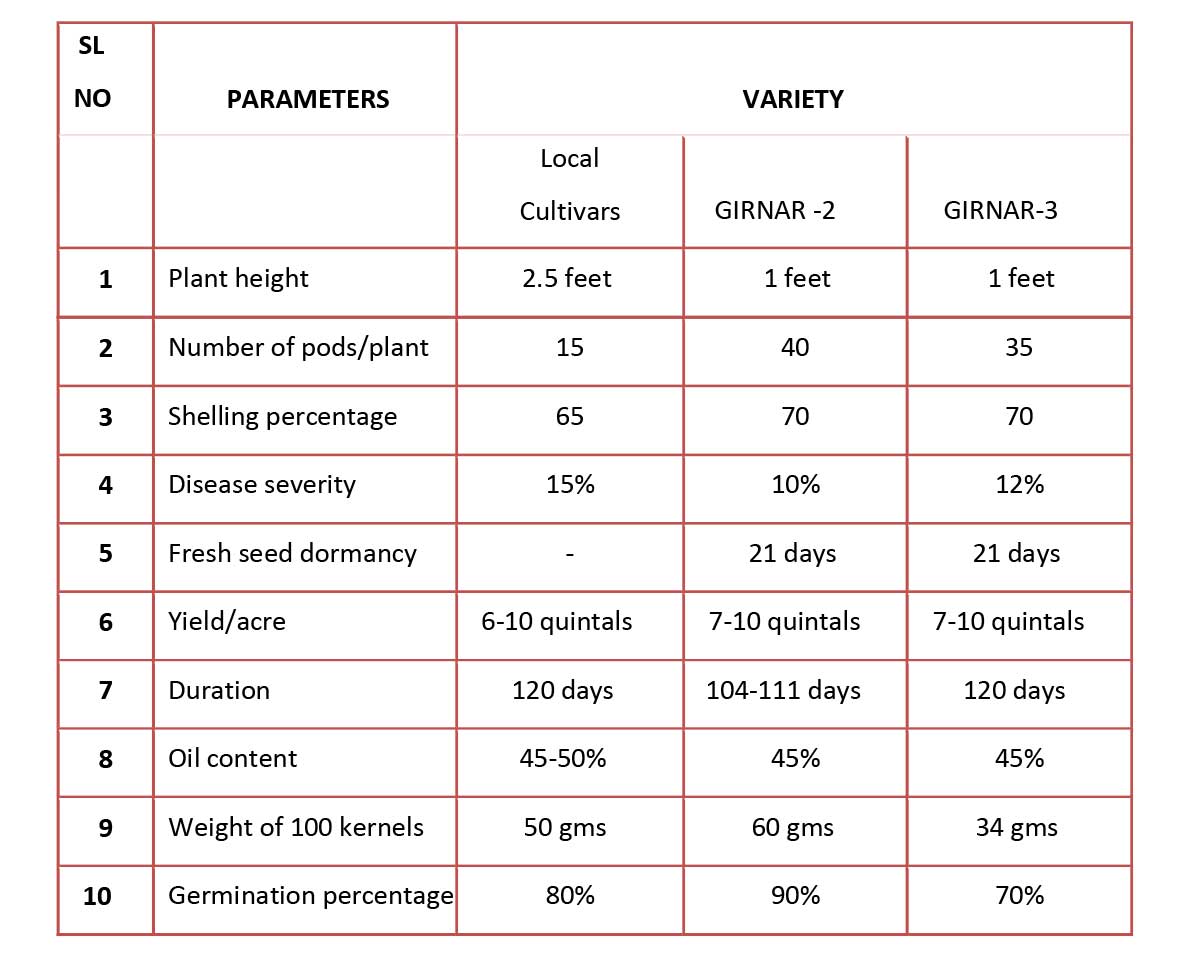
Table 8: Comparison of new varieties and local cultivar
Scientific storage of seeds
After the harvest, the farmers were interested in storing the groundnuts so that they could be used as seeds in the next season. Since the farmers were trying this for the first time, it was decided to come up with a small scale model for community based storage.
For storage, the seeds need to be dried in the sun till the moisture content in the seeds reaches 8% or less. After this, the seeds must be graded manually and the best pods should be packed in High Density Polythene bags along with Calcium chloride in small perforated jar to absorb any moisture. The bags should be sealed and placed in plastic/aluminum containers.
Since this is the first time farmers are storing seeds, we tried out a pilot model for community based seed storage. Each farmer has preserved 5kg of seeds in a common room in the village. We provided the farmers with plastic bags, containers and calcium chloride. 20 farmers have stored 6.5kg of seeds each. They can take back 5kg of seeds for sowing in the next season. The remaining 1.5kg of seeds was sold to cover the costs of storage. If the stored seeds germinate and produce good yield, this model can be taken up by the farmers or they can conserve the seeds at household level.
COMMUNITY BASED SEED STAMOUNT TO BE RETURNED NEXT
AMOUNT KEPT AS CONTINGENCY – 5%
COST OF STORAGE
NET REVENUE
AMOUNT OF SEEDSTOTAKENFROM AFARMER
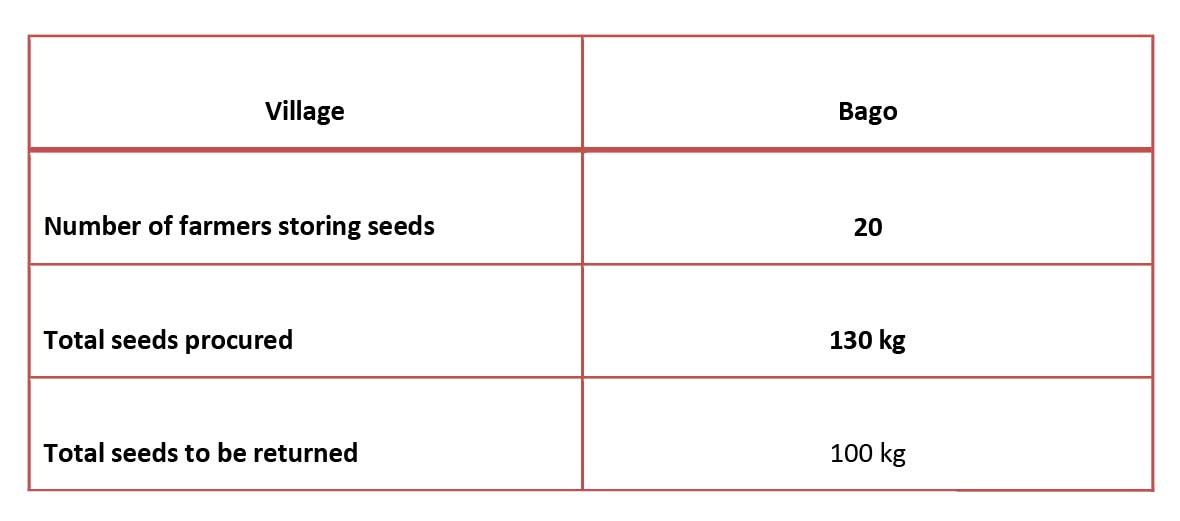 Seed multiplication in Khariff season
6kgs of the produce of Girnar-3 variety was taken from the Rabi farmers and given to two farmers in Raibanya Panchayat, where groundnut is sown in the Khariff season (June-October).
Seed multiplication in Khariff season
6kgs of the produce of Girnar-3 variety was taken from the Rabi farmers and given to two farmers in Raibanya Panchayat, where groundnut is sown in the Khariff season (June-October).
Two farmers have sown 3kgs of Girnar-3 seeds on small plots of land. This was done to evaluate the performance of these seeds for the Khariff season,
so that seeds can be circulated among farmers of other villages.
Outcomes
This small scale action-research project was an attempt to gain a basic understanding of the issues of the farming sector and designing, suitable, small scale solutions. The intervention has been piloted in the project location, the results of which will help DHAN Foundation to replicate the intervention in as many areas as possible. The main outcomes of the project can be summarized as follows: Introduction of genetically pure seeds of good variety among the farmers, who have no access to good seeds. Increase in productivity, as can be seen from the increase in number of pods/plant, with the change in sowing technique and new seeds.
Scientific storage method promoted among farmers, which can help reduce the cost of cultivation by 30%.
Sustainability
In order to make the project sustainable, it must be designed in a way that the beneficiaries can continue to reap the benefits of the project without constant hand-holding by the NGO. As a rural development fellow, I had to assure that if the farmers have benefitted from the project, the intervention must be made sustainable and replicable.
The community based seed storage model can serve as a convenient method of seed storage for farmers, if the stored seeds perform as well as new seeds. The community based storage model requires a person to charge, and is also a profitable venture, if done on a large scale. The farmers have been made familiar with the whole process, so that one of them can take lead and continue the model. Apart from this, the farmers can also try preserving their seeds in their houses, if that is a more convenient option.
It is with this objective in mind that DHAN Foundation has procured two quintals of breeder seeds of the variety Girnar-3 from ICAR-DGR for the next sowing season (October-December).
The seeds have been purchased at a price of Rs135/kg. However, the seeds will be given to farmers at a subsidy of 50%. The amount of seeds given to each farmer will be based on the requirement and size o landholding. A model of distribution through which seeds can be circulated among farmers will be implemented. A farmer taking seeds will be required to return some of the harvested seeds to DHAN
Foundation, which will further distribute the seeds to other farmers.
Way Forward
Next steps
The next steps to continue this intervention should be:
Procuring more high quality, genetically pure, seeds that can be conserved from reliable sources like research institutions, seed banks etc.
Replicating the intervention to other crops of the region, especially self- pollinated crops like pulses and oilseeds because they can be conserved.
Indigenous varieties of crops that have become extinct should also be promoted through this intervention.
Formation of more farmer groups, based on the crops grown should be formed and good quality, sustainable inputs can be distributed through these groups.
A detailed survey of inputs for all crops should be carried out to find out the ease of acquiring farm inputs. Based on this, DHAN can start supplying good quality inputs like heirloom seeds, organic fertilizers etc. at affordable prices.
Recommendations
Formation of seed banks: This intervention can be replicated into a large scale seed bank with physical infrastructure. The seed bank can store different varieties of all crops grown in the location, particularly heirloom seeds and can be made available to the farmer at cheap prices. The distribution model can be based on return-whatever-you-take model, to ensure a sustainable supply of seeds. The seed bank can also provide a storage facility for farmers to store their seeds. This step will go a long way in making farmers self-sufficient in seeds. With good infrastructure and an effective distribution model, a seed bank can be very beneficial to farmers.
Formation of FPO’s: An effective and regular mobilization process can eventually culminate into the formation of a farmer producer organization (FPO). An FPO can be very effective in helping farmers at each stage of the agricultural value chain- right from inputs to storage to marketing. Sustainable practices like using heirloom seeds, natural inputs etc can be
effectively promoted through an FPO.
Promoting natural inputs: Since the basic objective of this intervention is to reduce input costs and promote self-sufficiency, promoting the use of natural inputs (in alignment with the ZBNF model) and heirloom seeds can be an effective step. Trainings and awareness sessions can be given through farmer group meetings, followed by provision of natural inputs like bio-fertilizers and heirloom seeds.
